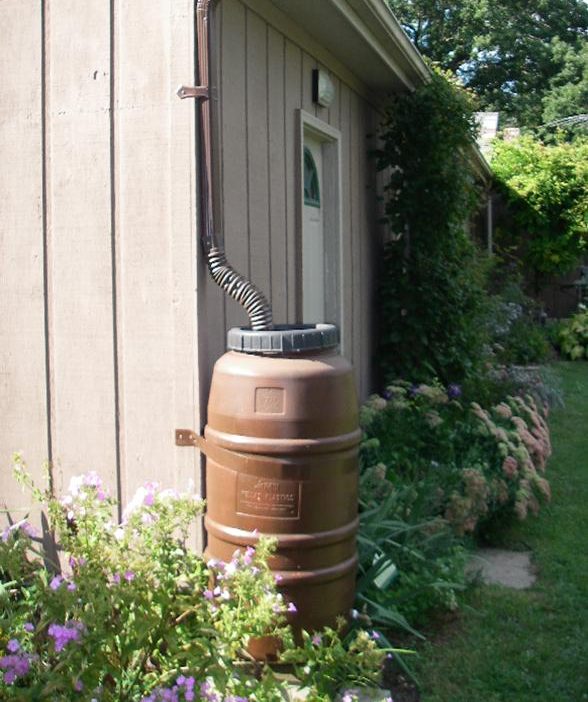Go Green at Home
Rain Barrel
Rain barrels harvest rain water from your roof and downspouts.
Harvesting Rainwater
You can use water collected in rain barrels to water your vegetables, lawn, and flowers while reducing your utility bills. Depending on your house and yard size, you can collect a significant amount of rainfall using your rain barrels. Estimates indicate during a one-inch rain event, one downspout delivers 12 gallons of water per minute and that one rain barrel will capture 1,300 gallons of water throughout the year. With rising municipal water rates and increasing drought concerns throughout the region, harvesting your own water through rain barrels is becoming more and more important and appealing.
Rainwater collection in barrels or other containers is an ancient and traditional practice. Every time it rains, water gushes from your downspouts across your lawn into local streets. Along the way the rainwater picks up pesticides, sediment, nutrients, and other pollution before flowing into local storm drains. Once in the storm drain system, polluted runoff is carried directly to the Wabash River.
Within portions of Greater Lafayette, polluted runoff combines with wastewater and flows untreated into the Wabash River. Installation of a rain barrel can reduce the flow of polluted runoff from your property. The more water you retain on site, the less water flows across the land surface, resulting in less sediment and nutrient polluted runoff flowing directly into the Wabash River.
Rain Barrel Maintenance
Rain barrels are easy to install, but they do require some maintenance.
March/April
- Install rain barrel or reconnect rain barrel to diverter after the last heavy frost.
- Be sure there is an overflow hose to accommodate heavy spring rains.
- If your barrel is full, empty it before the next rainfall.
Summer
- As needed: remove any leaves, twigs or other debris from the top of the rain barrel.
- Check fittings to ensure there is no leaking.
- If you have soaker hoses, ensure they are working properly and are not clogged. One way to unclog them is to use a hose with high pressure to clear them out.
- If your barrel is full, empty it before the next rainfall.
October
- Disconnect rain barrel from diverter before the first heavy frost.
- Drain the barrel and clean it out.
- Store inside a garage or storage shed, or flip upside down and secure it against an exterior wall.
- Open all the spigots to prevent any water from freezing inside and cracking the plastic.
Local Rain Barrel Sources:
If you are a resident of either Lafayette or West Lafayette, you can purchase 55-gallon rain barrels at a discount from your city. If you are a resident of Tippecanoe County outside of either city limits, you may still purchase your rain barrel through either city but will not receive the discount.
To purchase a barrel and diverter from the City of Lafayette, contact Lafayette Renew (765-807-1800).
To purchase a barrel and diverter from the City of West Lafayette, contact their waste water treatment plant: (765) 775-5145.
Rain barrels are also available at hardware stores and online in various shapes, sizes, and designs.
Local Resources:
Illustrated Rain Barrel Installation Guide
Rain Barrel Installation Video
Illustrated Rain Barrel Winterization Guide
Resources:
